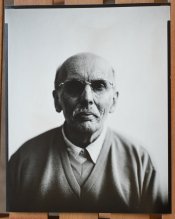Today I had time to do more reversal tests, with Arista grade 2 RC paper; week-old 1+20 Ilford multigrade paper developer replenished with 1cc of fresh concentrate; 200mL H20+1/5gram citric acid solution; 300mL 9% H2O2. The citric acid and peroxide were in separate trays, as I try a variation on what others have had good results with this week.
My processing methodology: developer 1:30; rinse in water bath :30; citric acid solution :30; peroxide bath 2:00 with GENTLE downward pushes with tongs; citric acid solution :30; peroxide bath 2:00 with GENTLE downward pushes with tongs (for a total of 5:00 bleaching time); thorough rinse under running water; fogging exposure :15 under enlarger at 16" height, f/22; standard develop, stop and fixer.
I first tried this new method on a 2-week old exposure that had been sitting in a film holder (image not shown). It reversed nicely, though the contrast was less than I expect (this was with the week-old 1+20 developer, prior to replenishment with 1cc fresh concentrate).
Next was a high-contrast morning scene in my back yard. ISO0.8, exposure 1/4s @ f/5.6. The print was very dark coming out of the first developer. Nothing much visible happened during the first :30 CA bath. But the print quickly began to bleach in the first 2:00 peroxide bath. Gentle downward pushes with tongs helps. Too much agitation doesn't work; too little doesn't work. The technique appears important, like with wet plate collodion. Into the 2nd :30 CA bath a bit more bleaching happens, due to H2O2 carry-over. During the 2nd 2:00 peroxide bath some residual gray tones bleach out, leaving only a few spots of faint gray with otherwise a white-looking print.
 Backyard001
Backyard001 by
Joe Van Cleave, on Flickr
Next I moved my Speed Graphic to the sunny front porch. These next three images were ISO 1.5, 0.8 and 0.8, respectively. The same observations apply during the bleaching steps.
 Pumpkin001
Pumpkin001 by
Joe Van Cleave, on Flickr
 Pumpkin002
Pumpkin002 by
Joe Van Cleave, on Flickr
 Pumpkin003
Pumpkin003 by
Joe Van Cleave, on Flickr
Note that these were high-contrast scenes, and the grade 2 paper seemed to represent the scene contrast pretty accurately. Some "freckle defects" were noted on some of the highlights, more so near the edges than the middle.
Next I wanted to try selfie portraits in subdued shade. These three are ISO 0.8, 0.8 and 1.5 respectively. Of the three I like the last one, at ISO 1.5, the best, despite the light leak from the film holder and wonky composition. Note the freckles defects again, affecting the highlights and more so near the edges.
 Joe001
Joe001 by
Joe Van Cleave, on Flickr
 Joe002
Joe002 by
Joe Van Cleave, on Flickr
 Joe003
Joe003 by
Joe Van Cleave, on Flickr
In all, I processed 8 prints with the same batch of chemicals. No evidence of exhaustion was seen, unless the freckles defects are an indication. I used 77mL of 35% H2O2 to make the 300mL of 9% concentration; and 1cc of fresh developer concentrate; along with 1/5 tsp of citric acid powder. A rather conservative usage, I'd say. Don't know how much further the bleaching would have gone.
I think it's important to go back and forth between the CA solution and peroxide. I let the prints drip just a bit between each. On one print I tried a 3rd round of :30 CA bath and 2:00 peroxide bath with no indication of further bleaching, indicating there's a limit to how far this method goes. But 5:00 total bleaching time is great. This is with a 9% peroxide concentration; a reasonable compromise between strength and safe handling.
I was happy to get good results for both sunny conditions and shaded light. The working ISO of 1.5 seems pretty consistent in both types of light for this Arista grade 2 RC paper. I should note that the contrast of the print with this grade 2 paper seems to depend a lot on the concentration of the first developer. With the week-old 1+20 concentration, the first print (not shown) was low contrast even though exposed in sunny conditions; while the 2nd print processed (the first one shown here) was very contrasty in similar light, but with freshly rejuvenated developer.
I heated my darkroom to mid-60s F with a space heater. No problems with bleaching at all, for 8 prints. I'm stoked. Hopefully I can do some 8x10 tests soon.
~Joe
EDIT: Note on the last image that the freckles defects are only seen in the fogged highlight area, indicating these are somehow related to the highlight exposure, and/or bleaching action. Note in the first pumpkin picture, at ISO 1.5, freckles are only seen on the stucco wall in the very brightest highlights.
Also, about 1 minute into the first peroxide bath the print suddenly does a sabbatier effect in the middle, as it begins to bleach. It's very noticeable, and a good indication that the bleaching is active.
NOTE: In the last three prints, spots and/or blemishes in the middle of the image are probably due to the tongs being used to push down the print in the peroxide bath, an indication of how sensitive the emulsion is during this step. A better way needs to be found to keep the paper submerged - like a thin vertical slot tank, perhaps.
The last three images were 2 second exposures. I used a 3-foot shutter release cable on the Fujinon 135/5.6 lens, and a focusing target with string attached to a yard stick for pre-focusing the camera, prior to being seated for the selfies.







 Backyard001
Backyard001 Pumpkin001
Pumpkin001 Pumpkin002
Pumpkin002 Pumpkin003
Pumpkin003 Joe001
Joe001 Joe002
Joe002 Joe003
Joe003